Ventilation
Storyboard 
For the waste to flow properly, it is necessary for air to enter the sewer system. Otherwise, voids would form, creating pressure differences that prevent the flow.
The problem is that this ventilation not only allows air to enter but also allows the exit of air containing molecules from the waste, which can be perceived as bad odors. Therefore, it is essential to locate the vents in a way that this air is diluted in the atmosphere, preventing it from reaching the inhabitants of the house and avoiding the perception of these odors.
Related topics
• Wind profile around the house
• Simulation of air flow around the house
ID:(118, 0)
Air flow around the house
Description 
In general, the airflow around the house is mostly turbulent, making its description complex. However, it is possible to estimate average flow velocities, which allows for graphical representations of an apparently smooth flow.
The house is oriented in the direction of the prevailing winds, which come from the northwest (usually with rain) or the southeast (usually without rain).
In the first case, it is observed how the flow tends to be elevated by the house, passing over the center and then descending behind it. In the central area, vortices are generated that rotate in the space of the entrance and kitchen window, rotating clockwise (negative), eventually forming a second vortex near the ground:
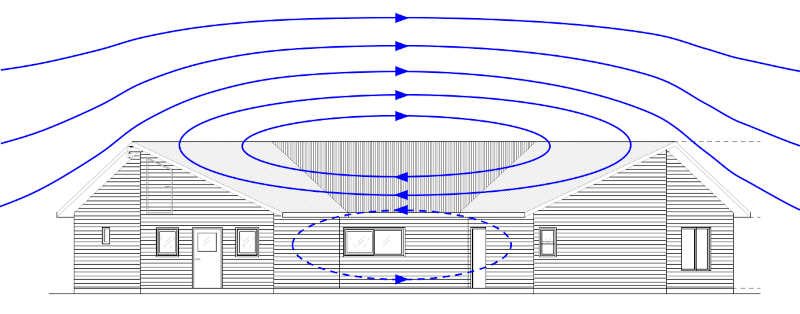
In the case that the wind comes from the southeast, and is generally dry, the generated vortex rotates counterclockwise (positive):
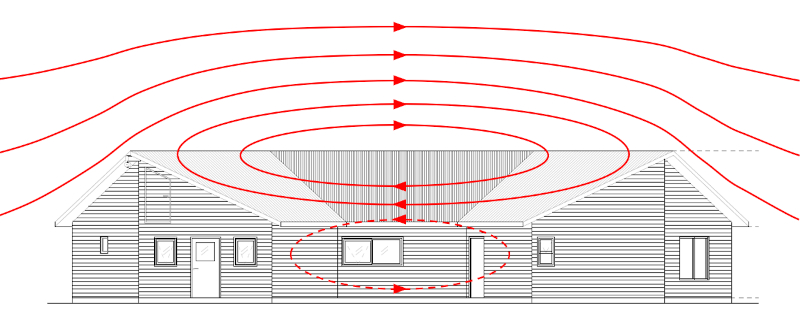
It is important to remember that this represents an average value, and that the actual flow presents a degree of vortices and general turbulence that are carried by the current.
Regarding the ventilation system, it should be ensured that the exhaust is directed towards the flow lines that carry odors away from the house. This way, the odors are diluted and eventually degraded by the environment, becoming harmless.
Therefore, it is concluded:
The ventilation pipes should be oriented towards the flow lines that move away from the house.
ID:(807, 0)
Turbulence at the edges of the roof
Description 
The airflow over the roof tends to be more uniform, and therefore the average value has a lower standard deviation. However, this changes at the edges, where more dramatic turbulence is generated.
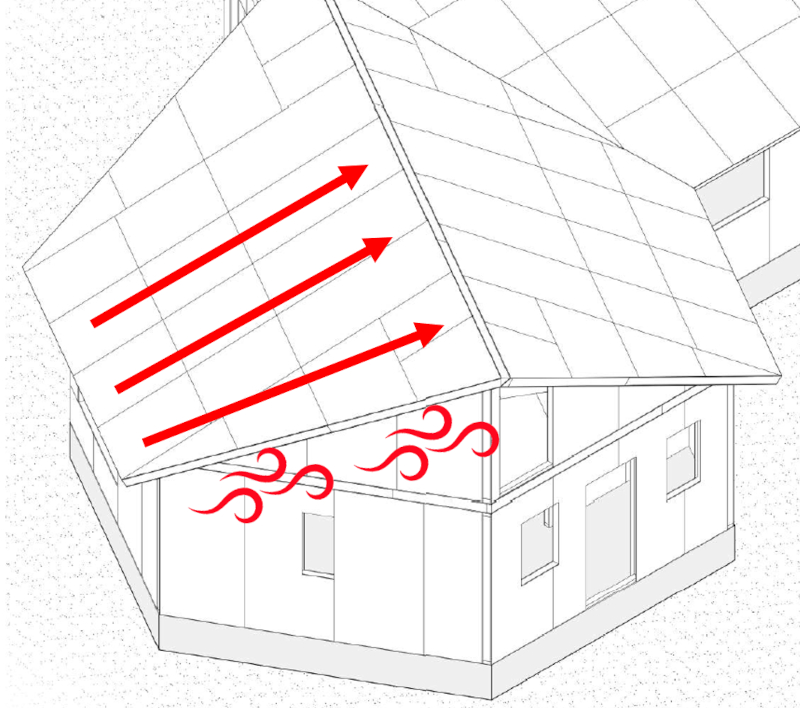
This effect is further exaggerated by the eaves, which create areas of lower velocity and consequently pressures that tend to divert the flow. This leads to the emergence of oscillating flows that can, at times, carry waste gases down to areas where the windows are located.
Therefore, it is crucial that:
The ventilation pipes should avoid the edges of the roof to prevent gases from being emitted in areas with flows that do not move away from the house, thus preventing the inhabitants from perceiving bad odors.
ID:(808, 0)
Air flow around the house
Description 
Ventilation pipes are part of the waste transportation system from the equipment (3) to the sewer system or septic tanks (4). They allow the entry of air (1) necessary to prevent the creation of vacuums that would literally suck the waste, impeding its transport (*). The problem is that this opening also allows the escape of gases from the sewer system or the septic tanks themselves (2):
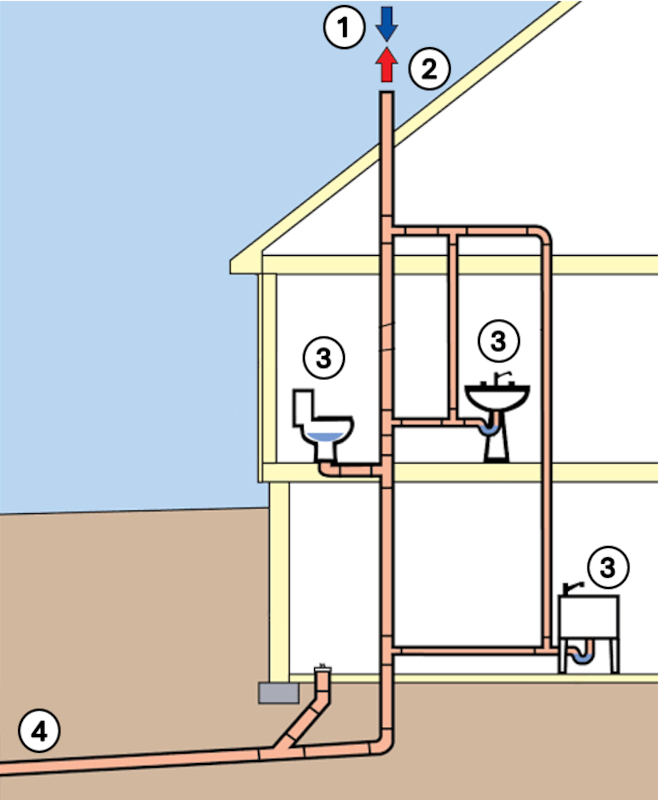
Although the odor can be partially reduced with additives, there is still the possibility that these gases will be perceived and inhaled before becoming completely harmless. Therefore, it is crucial to understand how they move and, thus, avoid interacting with them.
(*) To better understand the phenomenon, you can take a bottle, fill it with water, and invert it. You will see that the water does not spill. Only if you tilt it and allow air to enter, will the water flow out, which corresponds to the role of air in ventilation. The problem arises due to the atmospheric pressure we are exposed to. This pressure pushes the liquid into the bottle, overcoming the force of gravity that tries to extract it.
ID:(809, 0)
Waste gas outlet mechanism
Description 
There are two mechanisms by which waste molecules exit the ventilation pipe. The first is aerodynamic and occurs when there is wind that creates a pressure drop, causing the higher pressure in the sewer system to push the gases out. Once they emerge, they are carried by the airflow along the average flow lines:
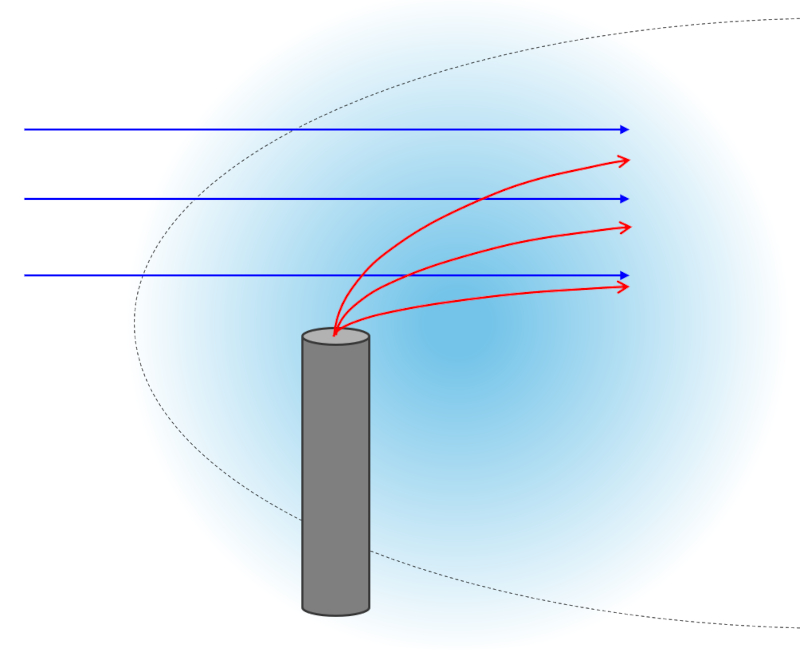
Since these lines are averages, they represent the general path that the molecules will follow, even though turbulence may cause random movement around them.
The second mechanism, which occurs when there is no wind, is the process of diffusion. This corresponds to the random movement of molecules due to their own velocity. Additionally, the effect of gravity causes the molecules to fall towards the surface around the pipe:
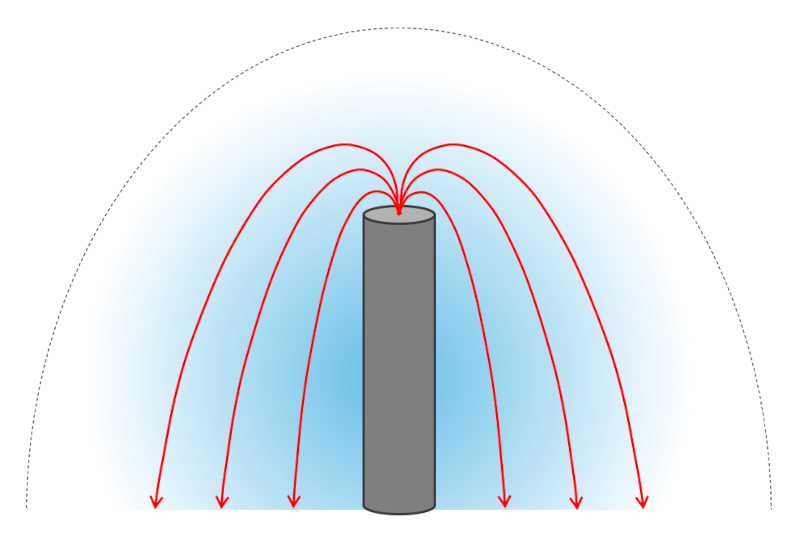
Most of the molecules will fall within an area with a radius similar to the height of the pipe. Therefore, if the pipe is at a distance greater than or equal to this height, the roof itself will act as a barrier, preventing the molecules from reaching the inhabitants of the house. The roof will retain the molecules until they degrade and can no longer be perceived.
Therefore, it is concluded that:
The ventilation pipe should be at a distance from the edge of the roof at least equal to its height above the roof.
ID:(810, 0)
Ventilation tube position
Description 
There are two mechanisms by which waste molecules exit the ventilation pipe. The first is aerodynamic and occurs when there is wind that creates a pressure drop, causing the higher pressure in the sewer system to push the gases out. Once they emerge, they are carried by the airflow along the average flow lines:
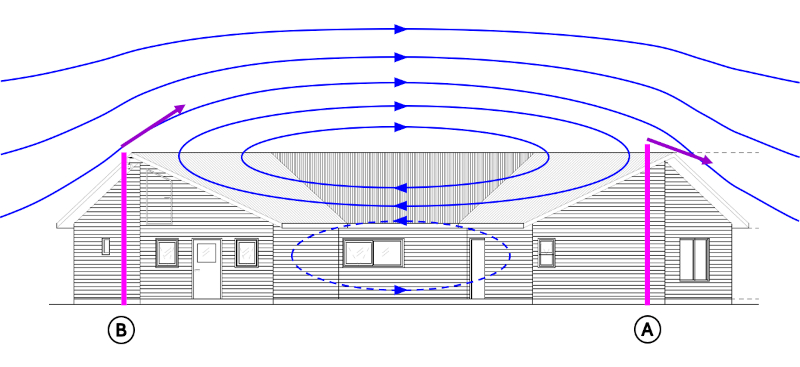
Since these lines are averages, they represent the general path that the molecules will follow, even though turbulence may cause random movement around them.
The second mechanism, which occurs when there is no wind, is the process of diffusion. This corresponds to the random movement of molecules due to their own velocity. Additionally, the effect of gravity causes the molecules to fall towards the surface around the pipe:
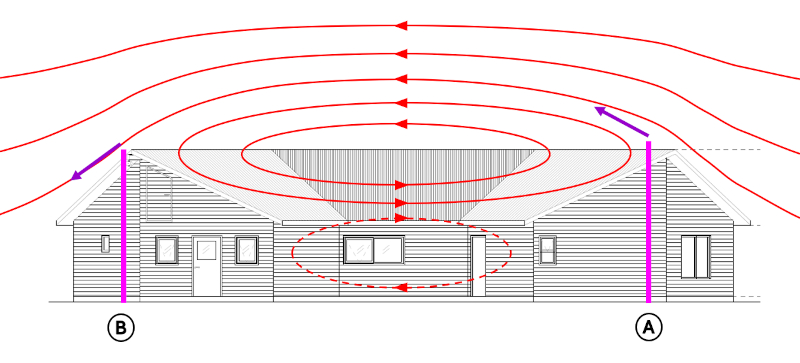
Most of the molecules will fall within an area with a radius similar to the height of the pipe. Therefore, if the pipe is at a distance greater than or equal to this height, the roof itself will act as a barrier, preventing the molecules from reaching the inhabitants of the house. The roof will retain the molecules until they degrade and can no longer be perceived.
Therefore, it is concluded that:
The ventilation pipe should be at a distance from the edge of the roof at least equal to its height above the roof.
ID:(811, 0)
Distance to roof edge
Description 
If the pipe ends at the edge of the roof, we encounter two problems:
• When there is no wind, diffusion could cause the molecules to descend into areas near windows, making them perceptible to the inhabitants of the house.
• When there is wind, the emission would occur in the turbulence zone, which at times may have flows towards the lower areas where the windows are located.
Both phenomena are represented in the following graphic:
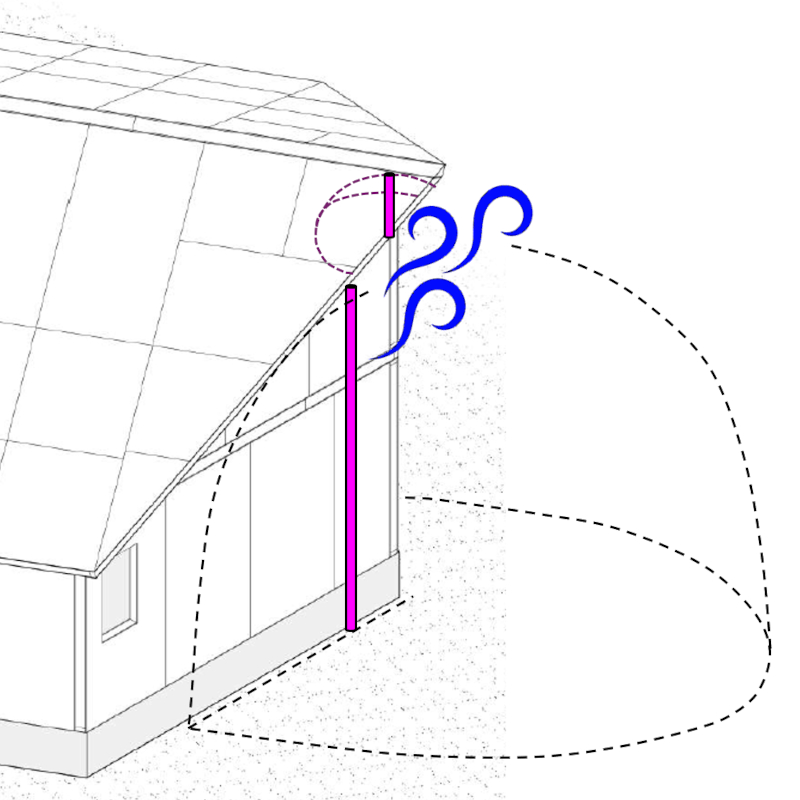
Moving the pipe away from the edge reduces both effects and, therefore, the likelihood of waste molecules reaching inhabited areas. This is illustrated in the following diagram:
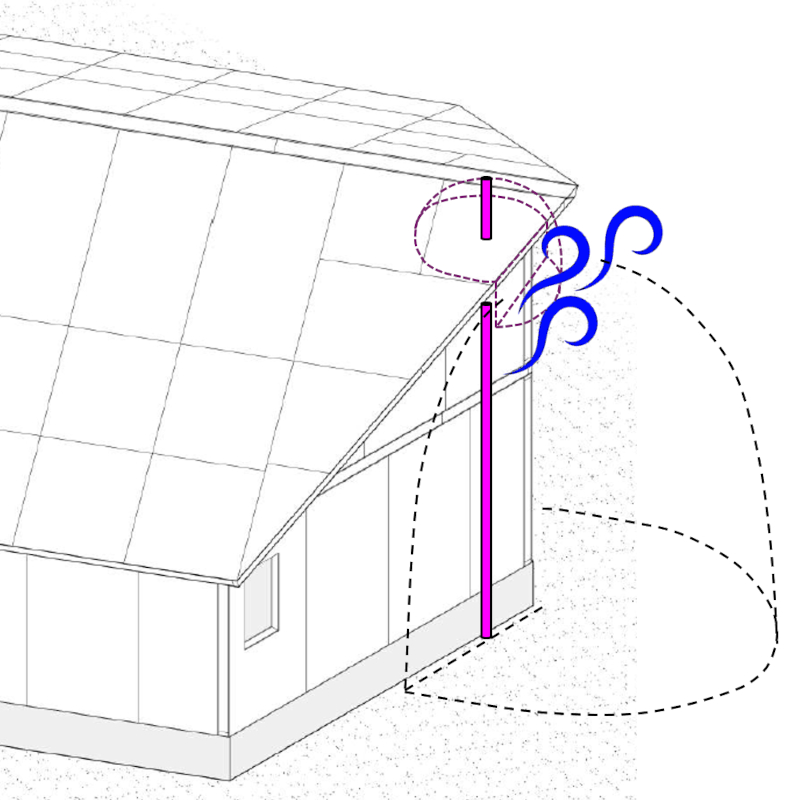
Therefore, we conclude that:
Ventilation pipes should be positioned as far as possible from the edge of the roof, preferably at a distance at least equal to their height above the roof.
ID:(812, 0)
Assembly of ventilation ducts
Description 
Considering the Household Water Supply and Sewerage Installation Regulations (RIDDA), which require ducts to have a diameter of 7.5 cm and a height above the roof of 60 cm, the following specifications are proposed:
Duct A:
• To ensure the duct intercepts a higher flow line, it is proposed that it extends 10 cm above the roof ridge.
• Since the pipe extends 60 cm, 50 cm of the pipe runs from the roof to the height of the ridge. With a roof inclination of 55%, it should be 87 cm from the corner.
• As it needs to be away from the roof edge, it is proposed that the pipe runs up the wall and passes through the roof, staying 63 cm from the eaves. This distance is similar to the height of the pipe above the roof, ensuring that much of the diffusion falls on the roof.
Duct B:
• As this pipe does not need to extend above the ridge, its height of 60 cm can go from the roof to the height of the ridge.
• Since the pipe runs 60 cm from the roof to the height of the ridge, with a roof inclination of 55%, it should be 105 cm from the corner.
• Similar to Duct A, it is proposed that the pipe runs up the wall and through the roof, staying 63 cm from the edge, corresponding to the size of the eaves.
The description is summarized in the following diagram:
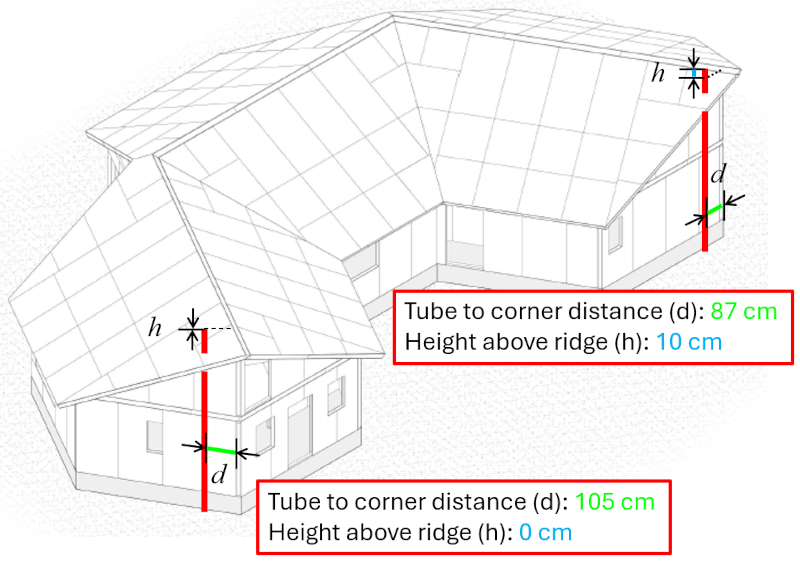
ID:(813, 0)
Ventilation of the drainage area
Description 
The drainage area produces methane as a result of organic matter decomposition, making proper ventilation essential. To address this, a ventilation pipe is installed between the septic tank and the drainage area:
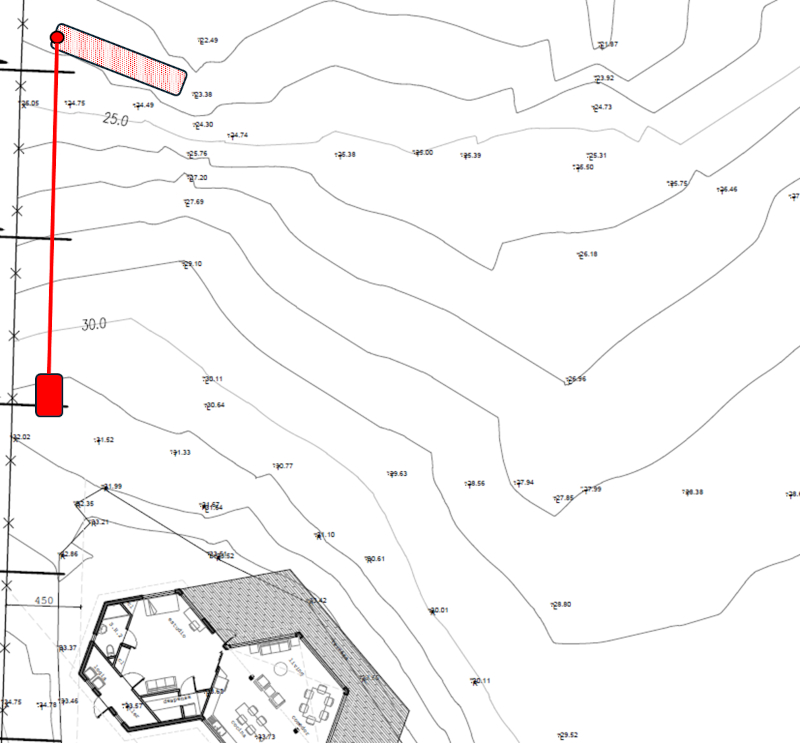
Ventilation pipe (marked in blue)
Initially, the ventilation pipe was over 3 meters tall, making it visible from the house. Additionally, the gases emitted could travel further distances:
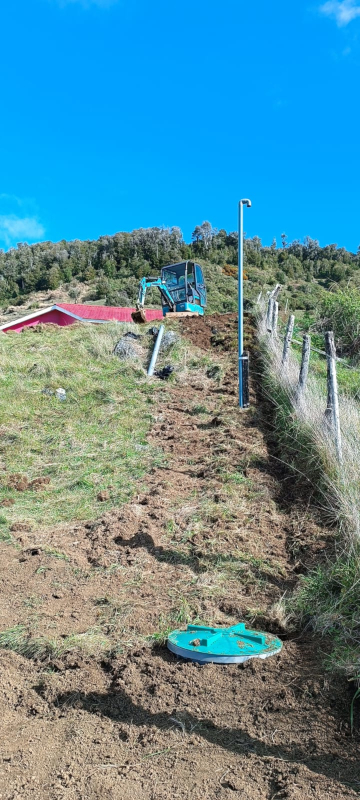
Tall ventilation pipe
Since the gases are directed towards a steep and inaccessible area, the pipe height was reduced by 2 meters. This adjustment allows the emissions to be absorbed by the vegetation in the inaccessible zone, as shown in the image:
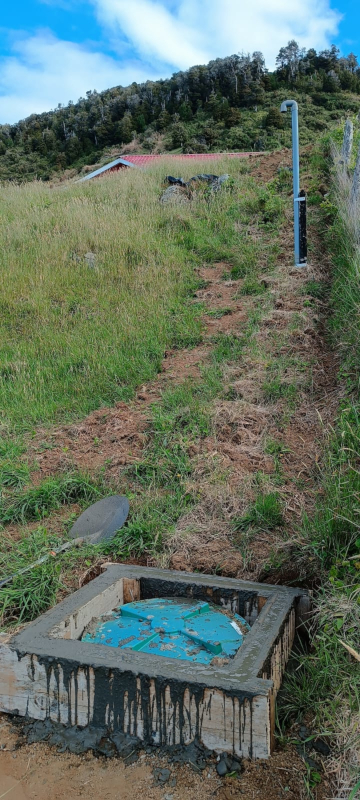
Lower ventilation pipe
With this modification, the ventilation pipe is no longer visible from the house, improving both the aesthetics and functionality of the system:

Ventilation pipe not visible from the house
ID:(814, 0)
